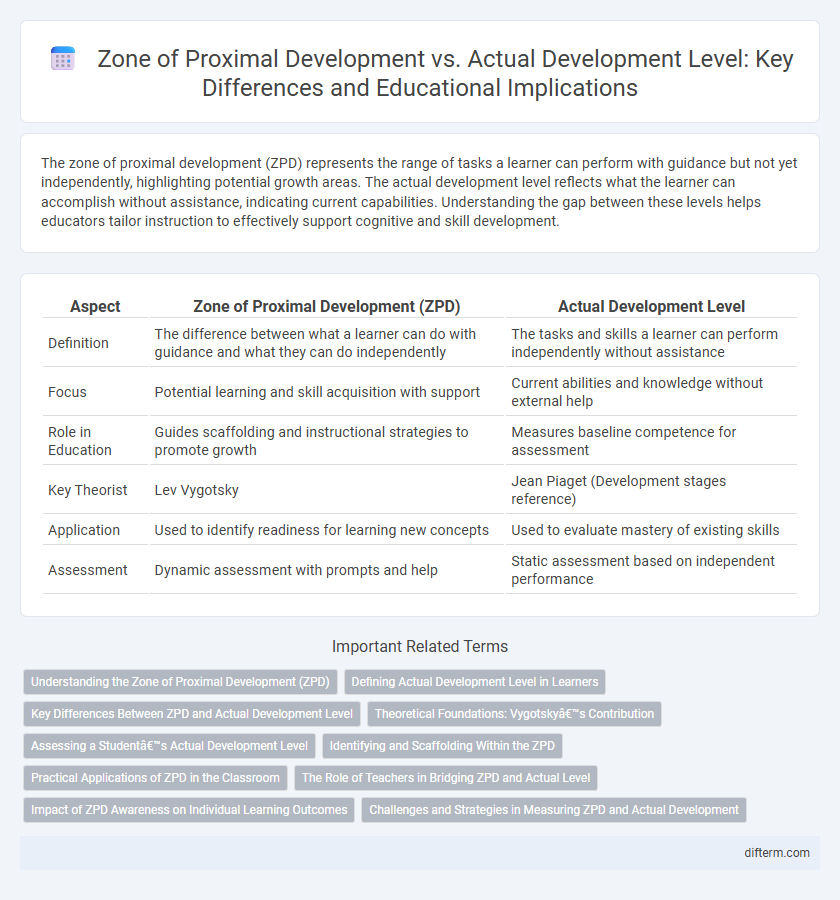The zone of proximal development (ZPD) represents the range of tasks a learner can perform with guidance but not yet independently, highlighting potential growth areas. The actual development level reflects what the learner can accomplish without assistance, indicating current capabilities. Understanding the gap between these levels helps educators tailor instruction to effectively support cognitive and skill development.
Table of Comparison
| Aspect | Zone of Proximal Development (ZPD) | Actual Development Level |
|---|---|---|
| Definition | The difference between what a learner can do with guidance and what they can do independently | The tasks and skills a learner can perform independently without assistance |
| Focus | Potential learning and skill acquisition with support | Current abilities and knowledge without external help |
| Role in Education | Guides scaffolding and instructional strategies to promote growth | Measures baseline competence for assessment |
| Key Theorist | Lev Vygotsky | Jean Piaget (Development stages reference) |
| Application | Used to identify readiness for learning new concepts | Used to evaluate mastery of existing skills |
| Assessment | Dynamic assessment with prompts and help | Static assessment based on independent performance |
Understanding the Zone of Proximal Development (ZPD)
The Zone of Proximal Development (ZPD) represents the range between a learner's actual development level, defined by tasks they can complete independently, and their potential development achievable with guidance from a more knowledgeable other. Vygotsky's concept emphasizes the critical role of social interaction and scaffolding in advancing cognitive growth beyond current abilities. Effective educational strategies target this zone to optimize learning by providing appropriate challenges that foster skill development and deeper understanding.
Defining Actual Development Level in Learners
Actual development level in learners refers to the skills and knowledge they have independently mastered without assistance, serving as a baseline for assessing current competencies. It reflects the learner's current cognitive abilities and problem-solving skills that are fully developed and accessible on their own. Understanding the actual development level is essential for educators to design appropriate instructional strategies that build upon existing knowledge and target the zone of proximal development effectively.
Key Differences Between ZPD and Actual Development Level
The zone of proximal development (ZPD) represents the range of tasks a learner can complete with guidance but not yet independently, while the actual development level reflects what the learner can achieve unaided. ZPD emphasizes potential learning capacity through social interaction, contrasted with the actual development level which measures current, independent performance. Understanding the distinction aids educators in tailoring instruction to bridge the gap between current ability and potential growth.
Theoretical Foundations: Vygotsky’s Contribution
Vygotsky's concept of the Zone of Proximal Development (ZPD) distinguishes between a learner's actual development level, defined by tasks they can complete independently, and their potential development, achievable through guidance and collaboration. This theoretical foundation emphasizes the social context of learning, where cognitive development is scaffolded through interaction with more knowledgeable others. Understanding the dynamic relationship between these developmental levels informs instructional strategies that optimize educational outcomes by targeting learners' emerging capabilities.
Assessing a Student’s Actual Development Level
Assessing a student's actual development level involves identifying tasks they can complete independently without assistance, reflecting their current competence. This evaluation contrasts with the zone of proximal development, which encompasses tasks the student can perform with guided support, highlighting their potential learning capacity. Accurate measurement of the actual development level enables educators to tailor instruction and provide appropriate scaffolding to bridge the gap toward advanced skills.
Identifying and Scaffolding Within the ZPD
The zone of proximal development (ZPD) defines the difference between what a learner can achieve independently and what they can accomplish with targeted guidance, emphasizing the need for precise assessment to identify this optimal learning zone. Scaffolding within the ZPD involves strategically designed support, such as modeling, prompting, and questioning, that gradually decreases as the learner gains competence and autonomy. Effective scaffolding aligns instructional strategies with the learner's current developmental level, fostering deeper understanding and skill acquisition.
Practical Applications of ZPD in the Classroom
The Zone of Proximal Development (ZPD) identifies the gap between what a learner can do independently and what they can achieve with guidance, enabling educators to tailor scaffolding strategies effectively. Practical applications in the classroom include differentiated instruction, peer collaboration, and guided questioning, which support students in mastering skills just beyond their current abilities. Utilizing ZPD enhances targeted learning experiences, promoting gradual independence and deeper cognitive development.
The Role of Teachers in Bridging ZPD and Actual Level
Teachers play a critical role in identifying each student's Zone of Proximal Development (ZPD) and tailoring instructional strategies to bridge the gap between the ZPD and the actual development level. By providing timely scaffolding, such as guided questioning, modeling, and feedback, educators facilitate cognitive growth and skill acquisition within this optimal learning zone. Effective teacher interventions not only support current task mastery but also promote independent problem-solving abilities, accelerating students' progression toward higher levels of competence.
Impact of ZPD Awareness on Individual Learning Outcomes
Awareness of the Zone of Proximal Development (ZPD) significantly enhances individual learning outcomes by enabling educators to tailor instruction to a learner's potential rather than current abilities. This targeted support bridges the gap between actual development level and potential development, fostering deeper cognitive growth and skill acquisition. Research indicates that learners guided within their ZPD demonstrate improved problem-solving skills, increased motivation, and accelerated mastery of complex concepts.
Challenges and Strategies in Measuring ZPD and Actual Development
Measuring the Zone of Proximal Development (ZPD) involves challenges such as accurately distinguishing between a learner's independent problem-solving ability (actual development level) and potential performance with guidance. Assessments must capture dynamic interactions, often requiring qualitative observations and adaptive tasks rather than static tests. Strategies to address these challenges include using scaffolding techniques, collaborative learning environments, and formative assessments tailored to identify the learner's potential growth areas within the ZPD.
zone of proximal development vs actual development level Infographic

 difterm.com
difterm.com